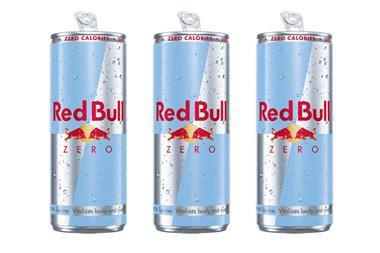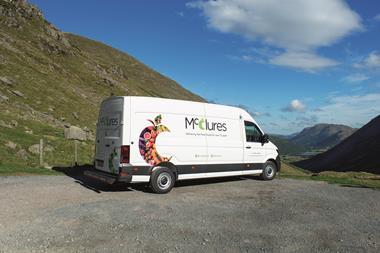When Sainsbury first told suppliers about plans to develop all new own label products on the internet, it was not bowled over by their enthusiasm, admits product development manger Cathy Port.
Aside from inevitable concerns over who was going to pay, there were lingering suspicions that this was a costly, time-consuming and gratuitous case of "harnessing the power of the net" for something that could be done just as easily by picking up the phone.
Seven months later, almost 400 of Sainsbury's own label suppliers have signed up to use the online Collaborative Product Development (cpd) tool from e-marketplace GlobalNetXchange, and the rest have pledged to get on board by the end of 2003.
The fact that just about every major grocery retailer, foodservice giant Brakes, and a clutch of fmcg brands are now following suit and striking up similar partnerships with software companies is further evidence that the rest of the industry is beginning to share Sainsbury's vision. Results vary by product category, but, typically, moving the npd process online can slash the time to market by up to a third.
So how does it work? In a nutshell, online cpd transfers the entire product development cycle to a website which becomes the sole source of information about the new product or range. A brief is logged into the system, a template is chosen, and a timetable set from concept to launch.
Tasks are then allocated to all parties involved in npd, from concept developers to printers, packaging designers, nutritionists and buyers who all get secure dial access to the site, 24-7. All they need is a web browser.
Any changes to the timetable, or a failure to complete a task on time, and all the relevant parties are automatically alerted by e-mail. It's not rocket science. In fact, it doesn't involve any fundamental changes in the npd cycle. What it does provide is one version of the facts surprisingly important when you consider what a game of Chinese whispers any process involving more than a handful of people can sometimes be. And it cracks the whip.
Software developer Ramesys, which is working with Asda, Tesco and Safeway on a similar system, says online CPD is merely a tool to help people work together more effectively. Business development director Kieran Forsey says: "This system allows things that used to happen in a linear way to happen simultaneously. Traditionally, developing a new product was like passing around a lever arch file, updating it, and giving it to the next person in the chain. Online cpd lets everyone look at the same file at the same time, from anywhere in the world."
While the software was not designed simply to root out weak links in the npd chain, it does identify stages in the process that tend to cause delays, says Sainsbury's Port. "We do use it partly as a performance management tool, and it shows us where the bottlenecks are."
The transparency of the system also curbs the usual recriminations after a cock-up as it provides a precise record of exactly who agreed to do what, and when they were supposed to do it by. More importantly, it keeps everyone in the loop. Ramesys' Forsey adds: "Suppliers said they often felt a bit detached from the whole process once it got past a certain stage. But the best thing about it is that things are not held up by waiting for someone to return a call, respond to a fax, or deal with the mail."
At the moment, sending in a spec or a brief for the attention of the retailer's technical manager can be an immensely frustrating process, says Forsey. "It finally comes back, and then you have to make amendments and go through the whole process again." Online cpd is a hi-tech way of kicking people up the backside and making the npd process more efficient.
Safeway head of analytical quality services Paul Raynor says online cpd is chiefly a communications tool: "Work doesn't just sit around. When a task is completed everyone knows and the next stage can begin." It also improves accuracy as data is not being re-keyed into computer systems from written documents. "Just sending copybriefs electronically to the artwork people really cuts down on silly mistakes."
Although there are differences between the various cpd software packages on offer from GNX, Ramesys and Brakes' chosen partner Tradinterchange, each comprises two basic components a product specification and technical information database, and a new product development workflow tool.
Some retailers, notably Asda and Tesco, have focused on the first component logging product specs onto the web database for due diligence purposes, while others Sainsbury, Brakes and Safeway have progressed rapidly on to npd.
In Asda's case, the online specs system from Ramesys has been developed into Web-Traqs a central repository for all its specs, technical policies, codes of practice and other due diligence information, and is now a key portal for communication on quality and technical issues. Crucially, it also serves as a traceability tool in the event of a food scare or a customer query by allowing third parties to identify all products containing a particular ingredient, for example.
Simply implementing this component has shaved three weeks off the npd cycle, taking it down from 28 to 25 weeks. Unusually, Asda is planning to phase in an npd component on non-food, rather than groceries, while Tesco is still exploring the benefits of extending the Ramesys system to npd.
Safeway, however, has embraced the technology with all guns blazing, says Paul Raynor: "We definitely took the big bang approach on this."
Phase one logging all product specs onto the system is largely complete, and phase two online npd starts in a matter of weeks. "We are scoping the npd project with Ramesys now," says Raynor. "Tests will begin on a live project in February." Phase three, which will allow suppliers to access a host of information about products and processes, including customer complaints, audit information and supplier visits, as well as specs, is scheduled for implementation between April and June 2003.
Sainsbury and Brakes, meanwhile, are implementing the two components online specs and npd at the same time with partners GNX and Tradinterchange respectively. The first Sainsbury products created on the net gourmet Indian meals, have already hit the shelves.
In all cases, talks over the thorny issue of who pays for the new technology are still progressing, but the initial costs said to be "significant" have largely been borne by the retailers. However, suppliers are expected to make a contribution later on as the systems become fully operational and the benefits of getting products to market more quickly become apparent to all parties.
The technology is still in its infancy, but just about everybody involved in npd has recognised that moving the process online can deliver a real competitive advantage, says Ramesys' Forsey. "This is one case where the internet can really add value."
{{ANALYSIS }}
Aside from inevitable concerns over who was going to pay, there were lingering suspicions that this was a costly, time-consuming and gratuitous case of "harnessing the power of the net" for something that could be done just as easily by picking up the phone.
Seven months later, almost 400 of Sainsbury's own label suppliers have signed up to use the online Collaborative Product Development (cpd) tool from e-marketplace GlobalNetXchange, and the rest have pledged to get on board by the end of 2003.
The fact that just about every major grocery retailer, foodservice giant Brakes, and a clutch of fmcg brands are now following suit and striking up similar partnerships with software companies is further evidence that the rest of the industry is beginning to share Sainsbury's vision. Results vary by product category, but, typically, moving the npd process online can slash the time to market by up to a third.
So how does it work? In a nutshell, online cpd transfers the entire product development cycle to a website which becomes the sole source of information about the new product or range. A brief is logged into the system, a template is chosen, and a timetable set from concept to launch.
Tasks are then allocated to all parties involved in npd, from concept developers to printers, packaging designers, nutritionists and buyers who all get secure dial access to the site, 24-7. All they need is a web browser.
Any changes to the timetable, or a failure to complete a task on time, and all the relevant parties are automatically alerted by e-mail. It's not rocket science. In fact, it doesn't involve any fundamental changes in the npd cycle. What it does provide is one version of the facts surprisingly important when you consider what a game of Chinese whispers any process involving more than a handful of people can sometimes be. And it cracks the whip.
Software developer Ramesys, which is working with Asda, Tesco and Safeway on a similar system, says online CPD is merely a tool to help people work together more effectively. Business development director Kieran Forsey says: "This system allows things that used to happen in a linear way to happen simultaneously. Traditionally, developing a new product was like passing around a lever arch file, updating it, and giving it to the next person in the chain. Online cpd lets everyone look at the same file at the same time, from anywhere in the world."
While the software was not designed simply to root out weak links in the npd chain, it does identify stages in the process that tend to cause delays, says Sainsbury's Port. "We do use it partly as a performance management tool, and it shows us where the bottlenecks are."
The transparency of the system also curbs the usual recriminations after a cock-up as it provides a precise record of exactly who agreed to do what, and when they were supposed to do it by. More importantly, it keeps everyone in the loop. Ramesys' Forsey adds: "Suppliers said they often felt a bit detached from the whole process once it got past a certain stage. But the best thing about it is that things are not held up by waiting for someone to return a call, respond to a fax, or deal with the mail."
At the moment, sending in a spec or a brief for the attention of the retailer's technical manager can be an immensely frustrating process, says Forsey. "It finally comes back, and then you have to make amendments and go through the whole process again." Online cpd is a hi-tech way of kicking people up the backside and making the npd process more efficient.
Safeway head of analytical quality services Paul Raynor says online cpd is chiefly a communications tool: "Work doesn't just sit around. When a task is completed everyone knows and the next stage can begin." It also improves accuracy as data is not being re-keyed into computer systems from written documents. "Just sending copybriefs electronically to the artwork people really cuts down on silly mistakes."
Although there are differences between the various cpd software packages on offer from GNX, Ramesys and Brakes' chosen partner Tradinterchange, each comprises two basic components a product specification and technical information database, and a new product development workflow tool.
Some retailers, notably Asda and Tesco, have focused on the first component logging product specs onto the web database for due diligence purposes, while others Sainsbury, Brakes and Safeway have progressed rapidly on to npd.
In Asda's case, the online specs system from Ramesys has been developed into Web-Traqs a central repository for all its specs, technical policies, codes of practice and other due diligence information, and is now a key portal for communication on quality and technical issues. Crucially, it also serves as a traceability tool in the event of a food scare or a customer query by allowing third parties to identify all products containing a particular ingredient, for example.
Simply implementing this component has shaved three weeks off the npd cycle, taking it down from 28 to 25 weeks. Unusually, Asda is planning to phase in an npd component on non-food, rather than groceries, while Tesco is still exploring the benefits of extending the Ramesys system to npd.
Safeway, however, has embraced the technology with all guns blazing, says Paul Raynor: "We definitely took the big bang approach on this."
Phase one logging all product specs onto the system is largely complete, and phase two online npd starts in a matter of weeks. "We are scoping the npd project with Ramesys now," says Raynor. "Tests will begin on a live project in February." Phase three, which will allow suppliers to access a host of information about products and processes, including customer complaints, audit information and supplier visits, as well as specs, is scheduled for implementation between April and June 2003.
Sainsbury and Brakes, meanwhile, are implementing the two components online specs and npd at the same time with partners GNX and Tradinterchange respectively. The first Sainsbury products created on the net gourmet Indian meals, have already hit the shelves.
In all cases, talks over the thorny issue of who pays for the new technology are still progressing, but the initial costs said to be "significant" have largely been borne by the retailers. However, suppliers are expected to make a contribution later on as the systems become fully operational and the benefits of getting products to market more quickly become apparent to all parties.
The technology is still in its infancy, but just about everybody involved in npd has recognised that moving the process online can deliver a real competitive advantage, says Ramesys' Forsey. "This is one case where the internet can really add value."
{{ANALYSIS }}



















No comments yet